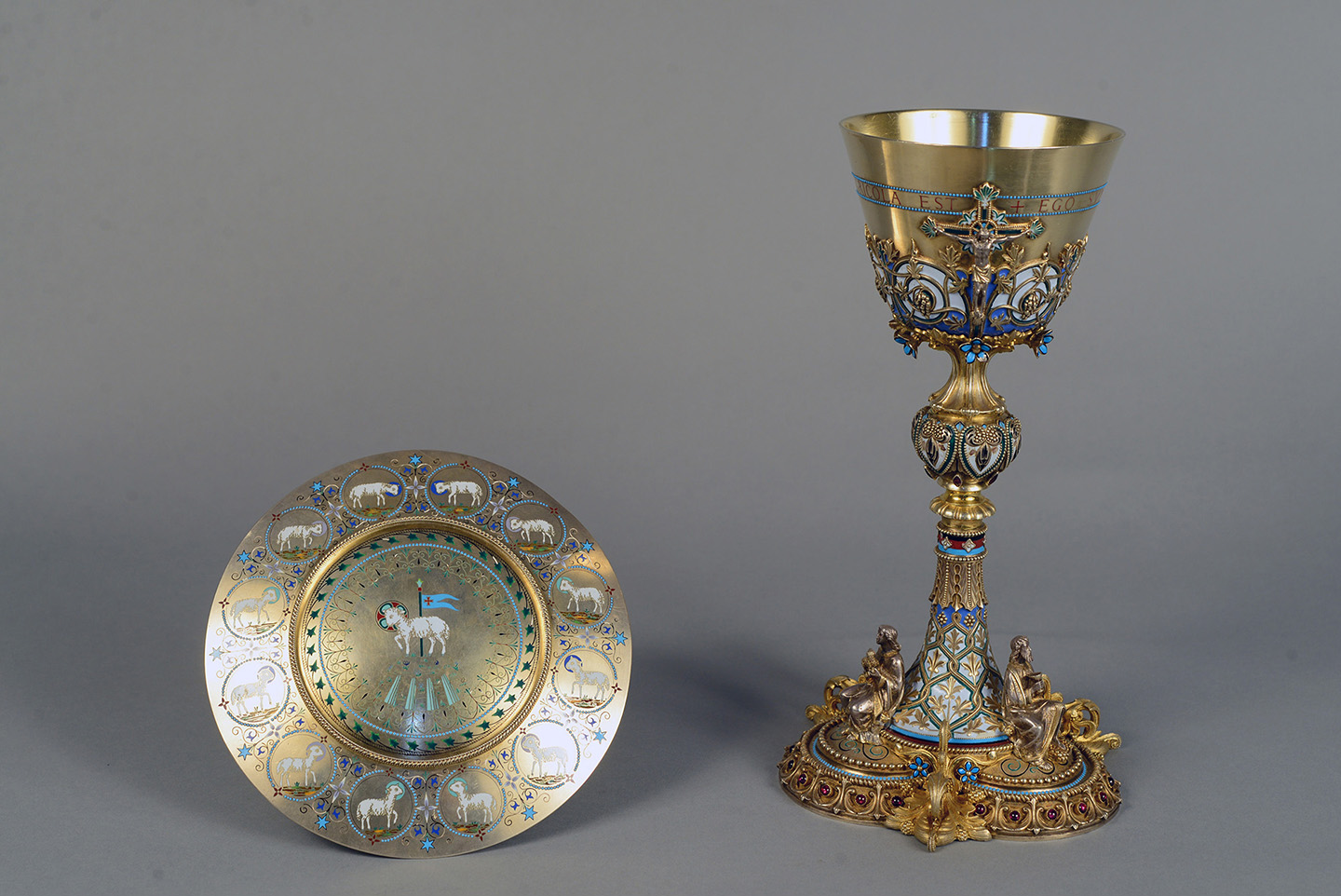Most altars in the Catholic faith are made of stone and represent the major space where important liturgical ceremonies are held in the church, serving also to symbolize the presence of Jesus' body. The altar is also the "Lord's Table" for sacred ceremonies held during the Sacrifice of the Mass. At the table, the priest takes unleavened bread and wine that has been consecrated and turns them into the body and blood of Jesus Christ to become the life-sustaining sustenance and spiritual drink for believers. The candles on and beside the altar stand for how Jesus brought light to a darkened world. The Lord's Table is also naturally an emotional reminder for the faithful of Jesus and the Last Supper with His disciples and the great unconditional sacrifice of His life for sinners.
Chalice with paten of Blessed Pope Pius IX (r. 1846-1878)
- Designed by Pierre Bossan, made by Thomas Joseph Armand-Calliat
- Donated by S.E. Mons. Pierre-Simon Marie de Dreux-Brézé and the marquis d'Aubigny, Moulins, France
- 1867, Lyon, France
- Length: 28.5 cm, width: 16 cm, height: 16 cm
- Collection of the Office for the Liturgical Celebrations of the Supreme Pontiff
This chalice was offered to Pope Pius IX by S.E. Mons. Pierre-Simon-Lois-Marie de Dreux-Brézé, bishop of Moulins (France), for the 50th anniversary of the episcopal consecration of Pope Pius IX in 1877.
The chalice is one of the objects designed by French architect Pierre Bossan for the Paris Universal Exhibition of 1867 and was made by Thomas-Joseph Armand-Calliat, a goldsmith from Lyon, in 1867. It was used by Pope Benedict XVI (r. 2005-2013) in the following celebrations: Solemnity of Mary, Mother of God, XLI World Day of Peace, January 1, 2008, in Saint Peter's Square, Vatican; Solemnity of Mary, Mother of God, XLII World Day of Peace, January 1, 2009, in Saint Peter's Square, Vatican; Memory of the Virgin Mary of Lourdes, XVIII World Day of the Sick, February 11, 2010, in Saint Peter's Square, Vatican.
This chalice with a paten is finely chiseled and enameled,also featuring inlaid semi-precious stones. The saucer is delimited on the top by a strip with a blue edge and an inscription in red quoting from the gospel. Below, on the base, tendrils and grapes in repoussé technique are on a white and blue glazed background; at the center is a crucifix with white and green enamels. On the base are six flowers with petals in blue enamel. The grip is a small column connected by a spherical knob with six repoussé shields and delimited by a small strip in green enamel with grapevines and ears of wheat; below the joint are six small garnets. On the lower part of the grip is very rich chiseling in polychrome enamel with silver-gilt and floral motifs that confer style and beauty to the whole object. The foot is divided in three semi-circles, on each one is a silver-gilt small statue in a seated position. The small statues represent Melchizedek raising a chalice, Abraham with the knife to sacrifice his own son, and Abel offering a lamb. On the same foot of the chalice, at the junction points of the three semicircles, are three floral motifs finely chiseled. On the outer edge is a series of 24 garnets, inserted in chiseled floral motifs, and a blue stippled twine together with six repoussé flowers, with blue glazed petals. On the bottom of the chalice is the number "17." The paten is totally different and made of translucent enamels and engravings. In the center is the paschal lamb with a halo and the banner of the Resurrection standing on a hill from where four brooks flow; the image is surrounded by a double circular decoration with flowers and vine leaves. All around are twelve haloed lambs, enclosed in turquoise circles united by arabesque designs, looking at the paschal lamb.
Inscription:
Ego sum vitis vera et Pater meus agricola est




